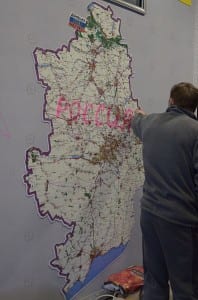South-Eastern Ukraine: Extremism and the Anti-Maidan
By Sean L Hanley, on 9 May 2014
Extremists have hijacked the Anti-Maidan protests in South-Eastern Ukraine and their extremism and ultra-nationalism are fomenting violence and hatred writes Anton Shekhovtsov
When masked men distributed anti-semitic flyers in the Eastern Ukrainian city of Donetsk, some international media outlets rather too hastily assumed that they were a hoax. The incident is still being investigated, so a definite conclusion cannot yet be reached. But even if the flyers are deemed to be a fake, the problem of anti-semitism, racism and homophobia inherent in some elements of the social unrest in Eastern Ukraine remains very real.
Allies of the now ousted president Viktor Yanukovych launched Anti-Maidan in Eastern and Southern Ukraine in late November 2013 as a response to Kyiv’s Euromaidan protests. But Maidan was a grassroots movement, whereas Anti-Maidan was a top-down initiative with protesters sometimes receiving remuneration for their participation. This was especially true of the four large Anti-Maidan rallies held in Kyiv between November 2013 and January 2014. Anti-Maidan organised many fewer protests than Euromaidan and they had started to die out long before Yanukovych fled from Ukraine to Russia.
However, the victorious Maidan revolution re-energised Anti-Maidan, which split into three different, but sometimes overlapping, movements: (1) protest groups mobilised by social grievances; (2) supporters of Ukraine becoming a federal state; and (3) Russian ultra-nationalists pursuing separatist ideas. They overlap because some of the activists mobilised by social grievances may support the federalisation of Ukraine (by which some actually mean joining Russia in the medium term), in contrast to pro-Russian separatists who insist on the immediate annexation of their region by Russia, as happened with the Autonomous Republic of Crimea.
The larger part of the post-Yanukovych Anti-Maidan movement is rooted in almost the same attitudes that underpinned Maidan, especially after the original pro-EU protests, focusing on a limited number of social demands, evolved into the Ukrainian revolution. Despite the different triggers, Maidan and post-Yanukovych Anti-Maidan were responses to socio-economic inequalities, unemployment, corruption, crime and a flawed justice system.
The major difference between these movements, however, is that they are dominated by two different narratives and offer two different solutions to their grievances. In inevitably idealised terms, Maidan’s narrative is democratic, while Anti-Maidan’s is authoritarian. Maidan suggests that social grievances can be addressed through closer cooperation with the democratic EU and the West in general, while Anti-Maidan believes that socio-economic problems can be tackled by closer cooperation with authoritarian Russia. Where relations with Russia are concerned, the more radical part of Maidan suggests enforcing a visa regime between the two countries, while radicals in Anti-Maidan insist that their region should become part of Russia. The more radical elements of Anti-Maidan are characterised by different linguistic preferences and choice of media as sources of information; their pro-Russian, anti-Western sentiments are rooted in the lower geographical mobility of Eastern Ukrainians. According to an opinion poll conducted in 2013, only 13.2% of Eastern Ukrainians have ever been to the West (EU, USA or Canada), a lower figure than for Ukraine as a whole, where the average is 20.6%. (more…)
 Close
Close



